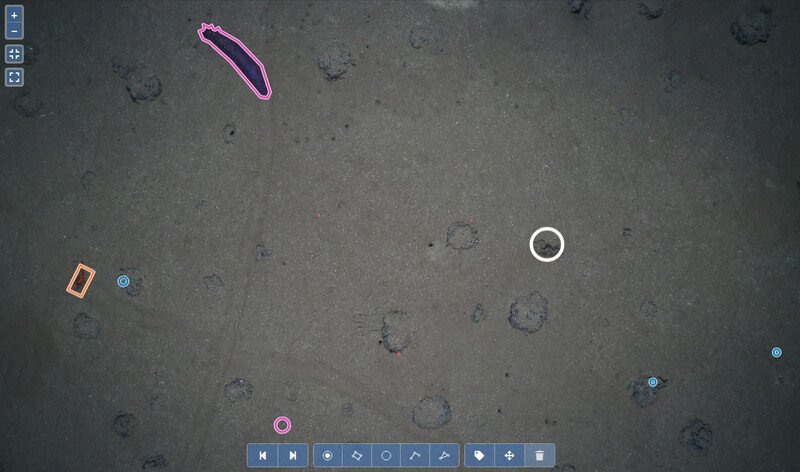Maximizing Efficiency with BIIGLE-Compatible Subsea Cameras & DVRs
Spanish oceanographic research ship, ESPS BIO HESPIRIDES A33
Marine research has been revolutionized by technological advancements, particularly in subsea imaging. A standout development is the compatibility of subsea cameras and DVRs with analytical tools like BIIGLE (Biodiversity Image Grid for Large-Scale Ecological). The SubC Imaging Rayfin camera and DVR+ Overlay exemplify this synergy, delivering exceptional imaging quality and seamless BIIGLE integration. But why is this compatibility important and how can it help boost research efficiency? This article explores how BIIGLE compatibility enhances marine research and the specific advantages it brings to the field.
What is BIIGLE?
BIIGLE is a sophisticated software tool designed for annotating and analyzing underwater images. Tailored to meet the demands of marine researchers, BIIGLE simplifies the examination of extensive datasets, aiding in the identification and cataloging of marine species and habitats. Its capabilities are indispensable for managing and interpreting the massive volumes of visual data generated by modern subsea cameras and DVRs. Through precise image annotation, BIIGLE enables detailed data recording, which is crucial for accurate scientific studies. The software supports efficient data management, allowing researchers to organize and retrieve images based on various criteria, thus streamlining the handling of large datasets.
BIIGLE also fosters collaborative research by permitting multiple users to access and annotate the same dataset, promoting teamwork and shared insights. The integration with geospatial data, such as GPS coordinates, further enhances its analytical power, enabling spatially-aware studies. By interpreting and utilizing embedded metadata, BIIGLE provides context and additional information for each image, enriching the data analysis process.
BIIGLE Software
Why Researchers Gain More with BIIGLE-Compatible Subsea Cameras and DVRs
Researchers gain more with BIIGLE-compatible subsea cameras and DVRs for several reasons:
📋 Standardization: Compatibility with BIIGLE ensures that images adhere to a standard format, facilitating easier integration and analysis within the software.
🗂️ Annotation and Analysis: BIIGLE provides advanced tools for annotating images, counting organisms, and analyzing biodiversity. Ensuring compatibility allows researchers to leverage these tools effectively.
🔗 Data Sharing and Collaboration: BIIGLE is widely used by multiple researchers and institutions globally. Compatible images can be easily shared and collaborated on within the BIIGLE platform.
⚙️ Efficient Workflow: Compatibility reduces the need for additional preprocessing steps, streamlining the workflow from image capture to analysis.
📝 Metadata Handling: BIIGLE can handle and interpret metadata embedded in JPEG images, which is crucial for maintaining context and ensuring accurate analysis.
In short, ensuring JPEG images are BIIGLE-compatible ultimately enhances the efficiency, accuracy, and collaboration potential in marine ecological research.
Elevating Research Quality Through BIIGLE Integration in Rayfin Cameras and DVRs
When researchers use the SubC Imaging Rayfin camera and DVR+ Overlay with BIIGLE integration, they experience a significant elevation in research quality through several substantial advantages:
📊 Enhanced Data Analysis: With BIIGLE compatibility, researchers can fully leverage the software’s powerful annotation and analysis tools. This capability is crucial for detailed studies of marine biodiversity and ecosystem health.
🔗 Seamless Integration: The seamless integration of Rayfin camera and DVR images with BIIGLE reduces the need for additional preprocessing, saving time and effort for researchers.
🗺️ Geospatial Context: The ability to embed GPS coordinates directly into the images ensures that each observation is accurately placed within its geographical context, enhancing the reliability of the research findings.
🤝 Collaborative Research: Compatibility with BIIGLE facilitates collaborative research efforts, allowing multiple researchers and institutions to work together on large datasets. This collaboration is essential for large-scale ecological studies and monitoring programs.
⚙️ Efficient Workflow: The streamlined workflow from image capture to analysis provided by the Rayfin camera and DVR+ Overlay, and BIIGLE compatibility allows researchers to focus more on their scientific objectives rather than data management tasks.
Further Enhancing Data with EXIF GPS Integration
Rayfin camera and DVR+ Overlay technology can also embed EXIF GPS latitude and longitude data in JPEG images. This significantly enhances their compatibility with BIIGLE. The spatial context provided by GPS data is indispensable for ecological studies, aiding in the precise mapping of observations and understanding biodiversity patterns. Combining visual data with geographical coordinates allows for more comprehensive analysis, correlating species distribution with specific locations and environmental conditions.
This integration of EXIF GPS data into BIIGLE’s analysis framework enriches the dataset, enabling spatial queries and geospatial analysis. Accurate location data enhances the reliability of research findings, ensuring that annotations and observations are correctly attributed to their geographic locations. GPS data also facilitates historical comparisons, allowing researchers to detect changes in species distribution and abundance over time. Additionally, embedding GPS coordinates in images simplifies data sharing with other researchers and institutions, ensuring access to precise location information.
Conclusion
The integration of subsea cameras and DVRs with analytical tools like BIIGLE represents a significant advancement in marine research. The seamless compatibility with BIIGLE enhances marine studies' efficiency, accuracy, and collaborative potential. As subsea imaging technology continues to evolve, the ability to capture, analyze, and interpret underwater data will play a critical role in advancing our understanding of marine ecosystems and informing conservation efforts.




